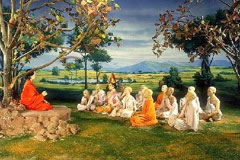முதன்மை பக்கம் » பொதுஅறிவு » History of India » Pre-Historic India » The Vedic Culture » Rig Vedic Age or Early Vedic Period
Rig Vedic Age or Early Vedic Period
Political Organization
The basic unit of political organization was kula or family. Several families joined together on the basis of their kinship to form a village or grama. The leader of grama was known as gramani. A group of villages constituted a larger unit called visu. It was headed by vishayapati. The highest political unit was called jana or tribe. There were several tribal kingdoms during the Rig Vedic period such as Bharatas, Matsyas, Yadus and Purus. The head of the kingdom was called as rajan or king. The Rig Vedic polity was normally monarchical and the succession was hereditary. The king was assisted by purohita or priest and senani or commander of the army in his administration. There were two popular bodies called the Sabha and Samiti. The former seems to have been a council of elders and the latter, a general assembly of the entire people.
Social Life
 |
| Rig Vedic Period |
Both men and women wore upper and lower garments made of cotton and wool. A variety of ornaments were used by both men and women. Wheat and barley, milk and its products like curd and ghee, vegetables and fruits were the chief articles of food. The eating of cow’s meat was prohibited since it was a sacred animal. Chariot racing, horse racing, dicing, music and dance were the favourite pastimes. The social divisions were not rigid during the Rig Vedic period as it was in the later Vedic period.
Information related to the search:
Rig Vedic Age or Early Vedic Period, vedic, period, india, women, history, unit, called, political, social, family, racing, society, head, popular, king, grama, basic, rivers, veda, indus, life, people, several, organization, families

